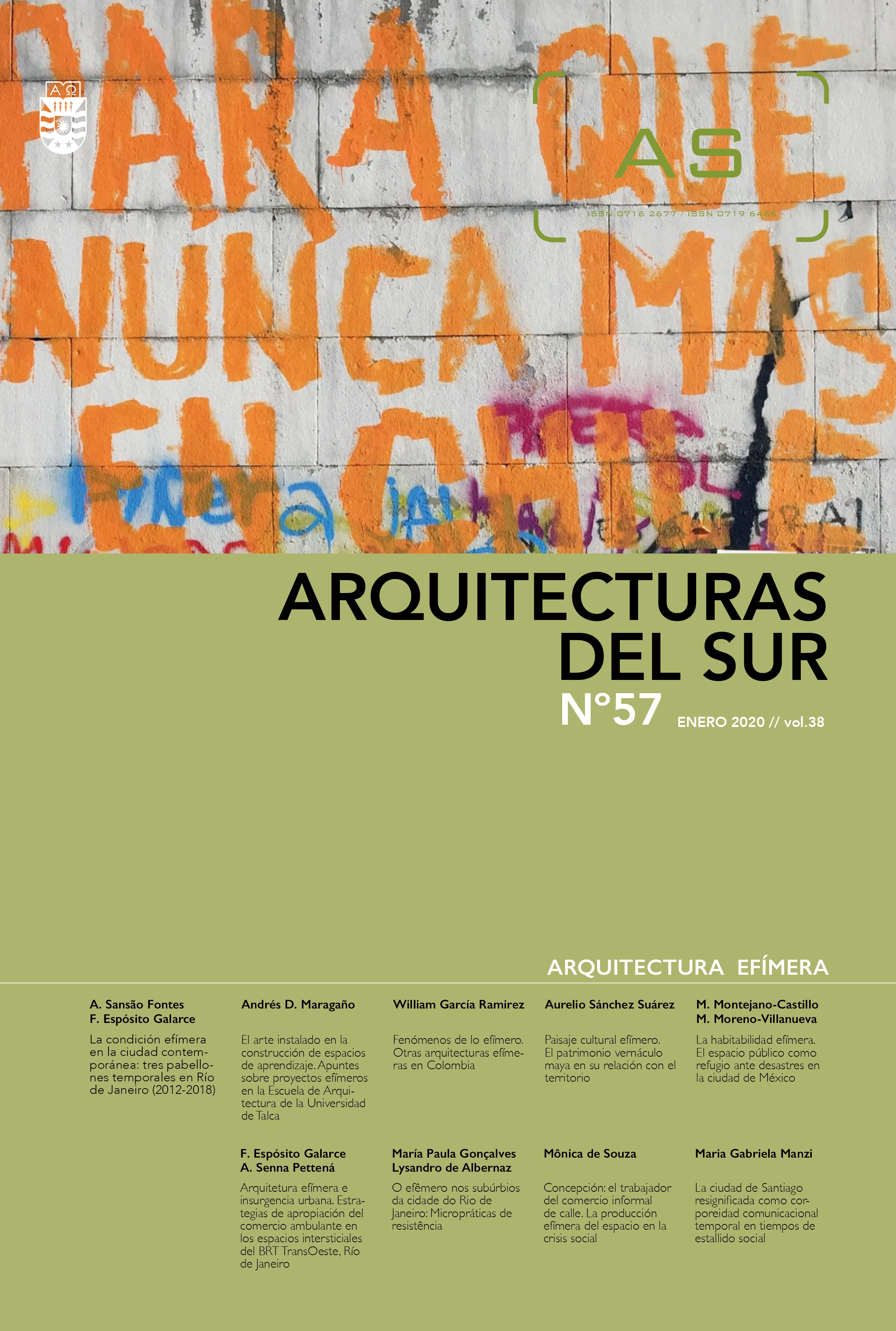Arquitectura efímera e insurgencia urbana. Estrategias de apropiación del comercio ambulante en los espacios intersticiales del BRT TransOeste, Río de Janeiro.
DOI:
https://doi.org/10.22320/07196466.2020.38.057.06Palabras clave:
Espacios intersticiales, movilidad urbana, análisis urbano, arquitectura efímera, apropiaciónResumen
La ciudad de Río de Janeiro pasó por importantes obras de reestructuración urbana en la última década. Su condición de ciudad anfitriona de la Copa del Mundo 2014 y los Juegos Olímpicos 2016 significó un importante proceso de transformación de gran parte de la ciudad. En este contexto, una de las intervenciones de infraestructura más importantes fue la implementación del sistema de BRTs (Bus Rapid Transit). En la mayoría de las estaciones es posible percibir una dinámica informal de usos no programados y apropiaciones efímeras, a través de objetos (soportes) que ocupan los "intersticios" que deja el sistema. Esta insurgencia reivindica nuevas posibilidades de interpretación de los espacios urbanos, una vez que revelan su potencial, ofreciendo respuestas a las demandas de servicios y productos en un contexto de movilidad cotidiana. El concepto de intersticialidad se propone en respuesta a la necesidad de nombrar el "entre" o lagunas del sistema BRT, que en la práctica, posee límites difusos. Lo que visibiliza esta dimensión intersticial son los habitantes y usuarios de estos espacios “entre”, a través de la apropiación efímera de la infraestructura de movilidad y sus alrededores. A través de una discusión bibliográfica, trabajo de campo, registro fotográfico y la categorización de los comportamientos observados y soportes efímeros detectados, este trabajo observa las apropiaciones efímeras de los espacios intersticiales del sistema BRT como un fenómeno que debe considerarse como parte de los sistemas urbanos.
Descargas
Citas
ALLEN, S. Infraestructural Urbanism. Revista Prumo. Cidades Latino Americanas , 2017, v. 2 n. 3, 178-189. Recuperado de https://issuu.com/revistaprumo/docs/prumo_3__vers__o_final___04_07_2017
CARERI, F. Walkscapes. O caminhar como prática estética. Barcelona: Editorial Gustavo Gili. 2013.
GONÇALVES, L. Mutações metropolitanas: estruturas viárias como lugar de apropriação, reinvenção e uso na cidade contemporânea. V!RUS, São Carlos, 2016. n. 13. Recuperado de http://www.nomads.usp.br/virus/virus13/?sec=4&item=4&lang=pt
HERCE, M. (2017). A ausência de projeto urbano nas obras de mobilidade no Rio de Janeiro. Revista Prumo. Cidades Latino Americanas, v. 2 n. 3, 86-92. Recuperado de https://issuu.com/revistaprumo/docs/prumo_3__vers__o_final___04_07_2017
JENNINGS, A. (2014). Brasil em jogo: o que fica da Copa e das Olimpíadas? 1 ed. – São Paulo: Boitempo: Carta Maior.
KOWALTOWSKI, D. C. C. K., & NEVES, L. de O. A compreensão do projeto como tópico de pesquisa. PARC Pesquisa Em Arquitetura E Construção, 2016, 7(2), 58-60. Recuperado de https://doi.org/10.20396/parc.v7i2.864797
LASSANCE, G. Sobre a oportunidade de um legado olímpico para o Rio. Revista Prumo. Cidades Latino Americanas, 2017. 2, n. 3, 76-85. Recuperado de <http://periodicos.puc-rio.br/index.php/revistaprumo/article/view/328>
LERNER, J. Acupuntura urbana. Rio de janeiro: São Paulo: Record. 2011.
LIMA, C. H. A cidade insurgente: estratégias dos coletivos urbanos e vida pública. Arquiteturarevista (UNISINOS), 2014, v. 10, n. 1, 31-36. Recuperado de http://revistas.unisinos.br/index.php/arquitetura/article/view/arq.2014.101.04
MARTIN, R. Sobre infraestructura. Entrevista (Pedro Correa, José Lemaître). Revista ARQ. 2018. Edit. ARQ. n. 99, 12-27.
MELLO, M.; VOGEL, A. Lições da rua: O que um racionalista pode aprender no Catumbi. En: Pensando no Rio, politicas publicas, conflitos urbanos, e modos de habitar. 2015. Niterói: Intertexto. p. 289-315.
MENDES, A.; LEGROUX , J. BRT Transoeste: conflitos urbanos e contradições espaciais na “cidade atrativa”. Revista Direito e Práxis. 2016, Rio de Janeiro, Vol. 07, N. 4, pp. 13-42.
POL, E. Em R. García-Mira, J.M. Sabucedo y J. Romay (Eds.) Psicología y medio ambiente. Aspectos psicosociales, educativos y metodológicos. A Coruña: Asociación Galega de Estudios e Investigacion Psicosocial-Publiedisa Pagin. 2002.
RIVERA, N., LEDEZMA, M. La ciudad como valor e identidade. En: Identidad y espacio público. Ampliando ambitos y prácticas (77-95). SÁNCHEZ, Diego, Domínguez, Luis Ángel (org). Edit. Gedisa S.A., Barcelona. 2014.
ROLNIK, R. Megaeventos: Direito à moradia em cidades à venda. En: Brasil em jogo. O que fica da copa e das olimpíadas? 2014. (65-70) Edi. Boitempo, São Paulo.
SENNET, R. Carne y piedra: El cuerpo y la ciudad en la civilización occidental. Madrid: Editorial Alianza. 1997.
SOLÀ-MORALES, I. Terrain vague. Arquitextos Vitruvius. 2012. Recuperado de http://www.archdaily.com.br/br/01-35561/terrain-vague-ignasi-de-sola-morales
VELLOSO, R. Apropriação, ou o urbano-experiência. Arquitextos Vitruvius. 2016. Recuperado de https://www.vitruvius.com.br/revistas/read/arquitextos/16.189/5949
Descargas
Publicado
Cómo citar
Número
Sección
Licencia
El contenido de los artículos que se publican en cada número de Arquitecturas del Sur, es responsabilidad exclusiva de los autores y no representan necesariamente el pensamiento, ni comprometen la opinión de la Universidad del Bío-Bío.
Las/os autoras/es conservarán sus derechos de autoría, sin embargo, garantizarán a la revista el derecho de primera publicación y difusión de su obra. La publicación del artículo en Arquitecturas del Sur está sujeta a la Licencia de Reconocimiento de Creative Commons CC BY-SA que permite a otros Adaptar: remezclar, transformar y construir sobre el material para cualquier propósito, incluso comercialmente, Compartir: copie y redistribuya el material en cualquier medio o formato, siempre y cuando se reconozcan la autoría y la primera publicación en esta revista citando correctamente, así como también sus nuevas creaciones estén bajo una licencia con los mismos términos.













 Programa de Información Científica/Concurso Fondos de Publicación de Revistas Científicas 2018/ Proyecto Mejoramiento de Visibilidad de Revistas UBB (Código:FP180007)
Programa de Información Científica/Concurso Fondos de Publicación de Revistas Científicas 2018/ Proyecto Mejoramiento de Visibilidad de Revistas UBB (Código:FP180007) 
